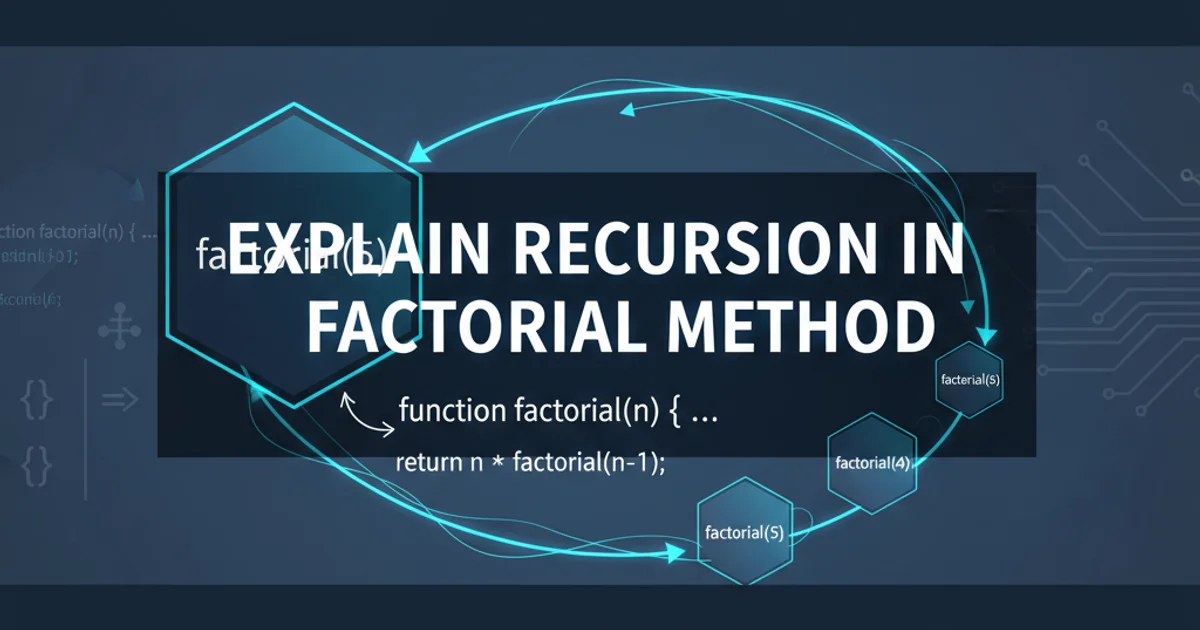Explain recursion in factorial method
Categories:
Understanding Recursion: A Deep Dive into the Factorial Method

Explore the concept of recursion through the classic factorial method. Learn how recursive functions call themselves to solve problems by breaking them down into smaller, identical subproblems.
Recursion is a powerful programming technique where a function calls itself directly or indirectly to solve a problem. It's often used when a problem can be broken down into smaller, identical subproblems. The factorial of a non-negative integer n, denoted as n!, is the product of all positive integers less than or equal to n. For example, 5! = 5 * 4 * 3 * 2 * 1 = 120. This article will explain how to implement the factorial method using recursion in Java.
The Core Concept of Recursion
At its heart, a recursive function must have two main components: a base case and a recursive step. The base case is a condition that stops the recursion, preventing an infinite loop. Without a base case, the function would call itself indefinitely, leading to a StackOverflowError. The recursive step is where the function calls itself with a modified input, moving closer to the base case with each call.
flowchart TD
A[Start factorial(n)] --> B{Is n == 0 or n == 1?}
B -- Yes --> C[Return 1 (Base Case)]
B -- No --> D[Return n * factorial(n-1) (Recursive Step)]
C --> E[End]
D --> AFlowchart illustrating the recursive factorial process
Implementing Factorial Recursively in Java
Let's look at how to implement the factorial method using recursion in Java. The factorial method will take an integer n as input. The base case will be when n is 0 or 1, in which case it returns 1. Otherwise, it returns n multiplied by the result of calling factorial with n-1.
public class Factorial {
public static long calculateFactorial(int n) {
// Base case: if n is 0 or 1, factorial is 1
if (n == 0 || n == 1) {
return 1;
}
// Recursive step: n * factorial(n-1)
else {
return n * calculateFactorial(n - 1);
}
}
public static void main(String[] args) {
int number = 5;
long result = calculateFactorial(number);
System.out.println("Factorial of " + number + " is: " + result); // Output: Factorial of 5 is: 120
number = 0;
result = calculateFactorial(number);
System.out.println("Factorial of " + number + " is: " + result); // Output: Factorial of 0 is: 1
number = 10;
result = calculateFactorial(number);
System.out.println("Factorial of " + number + " is: " + result); // Output: Factorial of 10 is: 3628800
}
}
Java code for calculating factorial using recursion
Understanding the Call Stack
Each time a recursive function calls itself, a new stack frame is pushed onto the call stack. This frame contains the local variables and parameters for that particular function call. When the base case is reached, the function starts returning values, and stack frames are popped off the stack in reverse order of their creation. This process is fundamental to how recursion works.
sequenceDiagram
participant Main
participant CF as calculateFactorial
Main->>CF: calculateFactorial(5)
CF->>CF: calculateFactorial(4)
CF->>CF: calculateFactorial(3)
CF->>CF: calculateFactorial(2)
CF->>CF: calculateFactorial(1)
CF-->>CF: Returns 1 (Base Case)
CF-->>CF: Returns 2 * 1 = 2
CF-->>CF: Returns 3 * 2 = 6
CF-->>CF: Returns 4 * 6 = 24
CF-->>Main: Returns 5 * 24 = 120Sequence diagram illustrating the call stack for factorial(5)
StackOverflowError if the stack limit is exceeded, especially with large inputs.